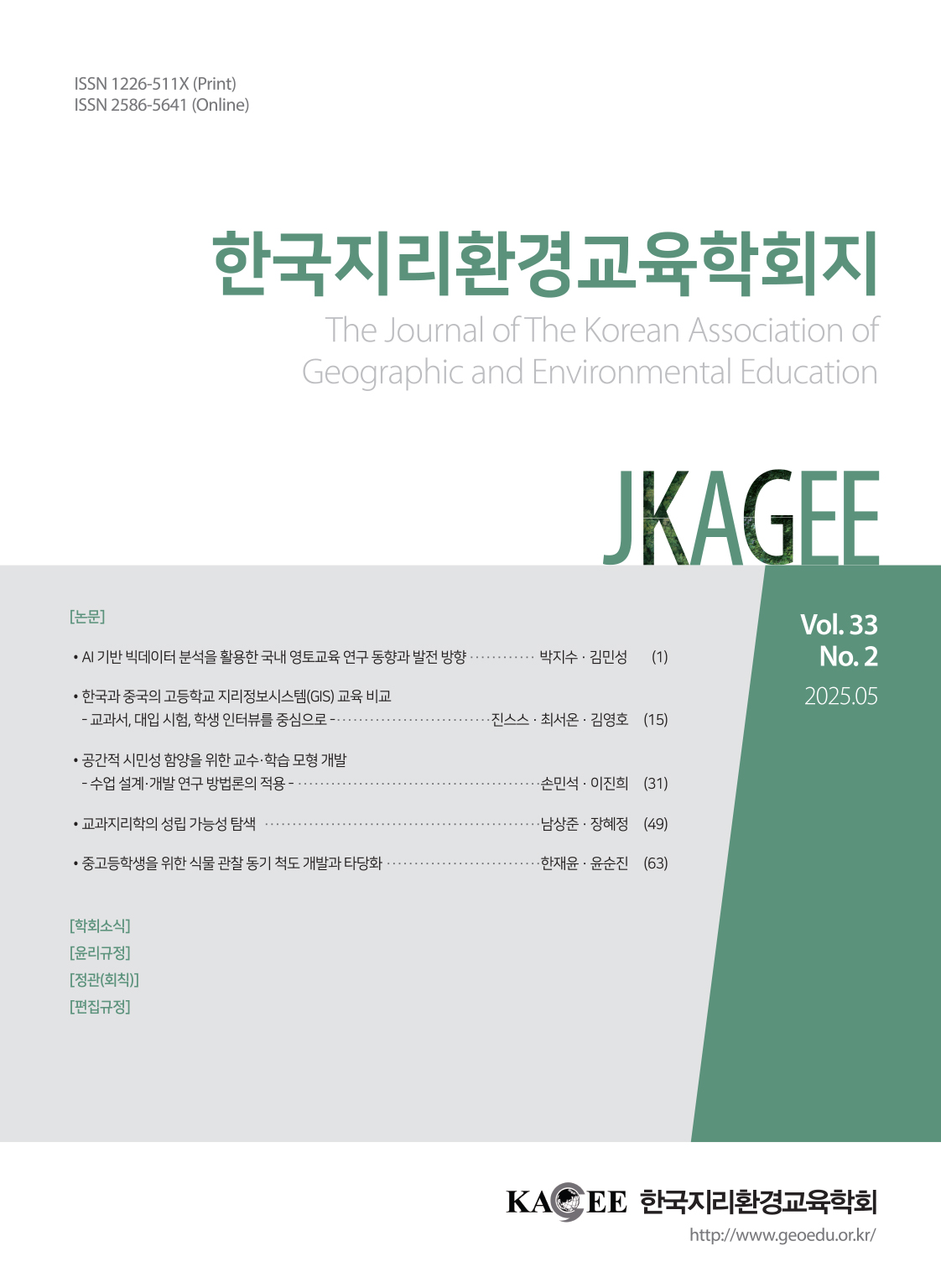Research Article
Abstract
References
Information
This study examines the characteristics and implications of recent changes in Australia’s elementary social studies curriculum (HASS F-6), especially the geography curriculum. Recently (2022), Australia’s national curriculum and social studies curriculum showed changes in aims, names of strands and sub-strands, and concepts of disciplinary thinking and interdisciplinary thinking. In particular, the emphasis on disciplinary knowledge and thinking concepts, and the refining and elaboration of the content of the achievement standards are notable features. In the case of the elementary geography curriculum, the ‘knowledge and understanding’ and ‘skills’ strands serve as the basic framework and central axis of content composition, while history, geography, civics, and economics each have their own domain names and achievement standards. These four domains are organized in a sequential overlapping methode, with history, geography, civics, and economics being incorporated as the grades progress. In terms of content selection and organization, seven major topics are selected and organized by grade, and all major topic names are combined with spatial and temporal scales, so both serve as the essence of composing learning content and scope. Major topics are arranged by grade in a horizon-expanding manner. In terms of knowledge and understanding strand, the topic of geography is basically region-centered, but also shows a combination of topic-centered content in middle grades (Y4) and above. In terms of skill strands, geography learning activities are organized so that there is clear differentiation and sequencing in the level of learner behavior and types of material use as the grades progress. Australia’s primary geography curriculum provides us with implications such as sequential overlapping of domains, integration of content through a single major topic for each grade and explicit spatial scale for each major topic, sequencing of behavoir and material levels by skills according to grade, and geographic elaboration of achievement standards.
이 연구는 오스트레일리아의 초등사회과(HASS F-6), 특히 지리 교육과정의 최근 변화 특성 및 함의를 고찰한 것이다. 최근(2022) 오스트레일리아의 국가 교육과정 및 사회과 교육과정은 목표, 스트랜드 및 하위 스트랜드의 명칭, 학문적 사고 개념 및 학제적 사고 개념 등에 변화가 나타났다. 특히, 학문적 지식과 사고 개념이 강조되는 점, 성취기준의 내용을 정련하고 정교화(elaboration)한 점이 두드러진 특징이다. 초등지리 교육과정의 경우, ‘지식·이해’ 및 ‘기능’ 스트랜드(strands)가 내용 구성의 기본 틀이자 중심축으로 작용하는 가운데, 역사, 지리, 시민, 경제가 각각 독자적인 영역 명과 성취기준을 지닌다. 이 네 영역은 학년이 올라감에 따라 역사와 지리, 시민, 경제 순으로 편입되는, 순차적 중첩방식으로 조직된다. 내용 선정 및 조직 면에서는 7개의 대주제가 선정되어 학년별로 계열화하여 있고, 모든 대주제 명에는 공간 및 시간 스케일이 결합하여 있어 양자가 학습 내용 및 범위 구성의 요체로 작용하고 있다. 대주제는 지평 확대 방식으로 학년별로 배열된다. 지식·이해 스트랜드 면에서 지리 주제는 기본적으로 지역 중심적 성격을 띠는 가운데서도 중학년(Y4) 이상에서 주제 중심적 내용도 복합된 특징을 보인다. 기능 스트랜드 면에서 지리 학습 활동은 학년이 올라감에 따라 학습자의 행동 수준 및 자료 활용 유형에서 명확한 차별화와 계열화가 이루어지도록 조직되어 있다. 오스트레일리아의 초등지리 교육과정은 우리에게 영역의 순차적 중첩, 학년별 단일 대주제를 통한 내용 통합 및 대주제별 공간적 스케일 명시, 학년에 따른 기능별 행동 및 자료 수준의 계열화, 성취기준의 지리교육적 정교화 등의 함의를 제공해 준다.
- 김다원, 2016, “세계시민교육에서 지리교육의 역할과 기여: 호주 초등 지리교육과정 분석을 중심으로”, 한국지리환경교육학회지, 24(4), 13-28.
- 김선영, 2019, “싱가포르와 호주의 지리과 교육과정 분석을 통한 우리나라 역량기반 교과 교육과정 문서 체제의 대안적 방향 고찰”, 학습자중심교과교육연구, 19(23), 285-312.
- 김재우·김동진·모경환, 2016, “2015개정 사회과 교육과정의 성취기준 특징 분석: 호주 사회과 교육과정의 비교를 중심으로”, 시민교육연구, 48(4), 27-48.
- 김현미, 2014, “오스트레일리아의 핵심역량 기반 국가 수준 지리 교육과정 탐색”, 한국지리환경교육학회, 22(1), 33-43. 10.17279/jkagee.2014.22.1.33
- 박은아, 2019, “사회과 교육과정의 핵심개념 국제 비교: 한국, 미국, 싱가포르, 캐나다, 호주를 중심으로”, 시민교육연구, 51(2), 95-126. 10.35557/trce.51.2.201906.004
- 박은아, 2020, “해외 사회과 교육과정 비교를 통한 역량기반 사회과 교육과정 구성의 시사점 탐색”, 교육과정평가연구, 23(1), 1-29. 10.29221/jce.2020.23.1.1
- 배화순, 2019, “외국의 사회과 교육과정 분석을 통한 시민교육으로서의 사회과 법교육 방향 탐색: 독일 베를린주와 호주를 중심으로”, 법교육연구, 14(1), 1-31. 10.29175/klrea.14.1.201904.1
- 윤지영, 온정덕, 2017, “외국의 사회과 교육과정 분석을 통한 역량기반 교육과정에서 기능의 의미와 설계 방식 고찰”, 학습자중심교과교육연구, 17(13), 315-345.
- 이간용, 2019, “독일의 초등 지리교육과정 변화 특성 및 그 함의 고찰”, 한국지리환경교육학회지, 27(2), 1-17.
- 이간용, 2020, “오스트레일리아의 지리평가 특성 고찰”, 한국지리환경학회지, 28(2), 125-144.
- 이경한, 2015, “유네스코 세계시민교육과 세계지리의 연계성 분석”, 국제이해교육연구, 10(2), 45-76.
- 조철기·김현미, 2018, “오스트레일리아 지리교육과정과 지역지리의 위치”, 한국지역지리학회지, 24(4), 529-541. 10.26863/JKARG.2018.11.24.4.529
- ACARA, 2012, The Shape of the Australian Curriculum(Version 4.0), Australian Curriculum, Assessment and Reporting Authority. retrieved from https://acaraweb.blob.core.windows.net/resources/The_Shape_of_the_Australian_Curriculum_v4.pdf
- ACARA, 2013, The Australian Curriculum: Geography, Australian Curriculum, Assessment and Reporting Authority. retrieved from http://www.australiancurriculum.edu.au/Geography/Curriculum/F-10.
- ACARA, 2015, Humanities and Social Science(Version 8.4) HASS F-6/7, Australian Curriculum, Assessment and Reporting Authority. retrieved from https://www.australiancurriculum.edu.au/f-10-curriculum/humanities-and-social-sciences/hass/
- ACARA, 2020, The Shape of the Australian Curriculum(Version 5.0), Australian Curriculum, Assessment and Reporting Authority. retrieved from https://www.acara.edu.au/docs/default-source/curriculum/the_shape_of_the_australian_curriculum_version5_for-website.pdf?sfvrsn=2
- ACARA, 2022, Humanities and Social Science(Version 9.0) HASS F-6, Australian Curriculum, Assessment and Reporting Authority. retrieved from https://v9.australiancurriculum.edu.au/downloads/learning-areas#accordion-772c275448-item-bb3ff5cad3
- Council of Australian Governments Education Council, December 2019,
Alice Springs (Mparntwe) Education Declaration . - GA, 2022,
A Framework for the School Geography Curriculum. - Ministerial Council on Education, Employment, Training and Youth Affairs, December 2008,
Melbourne Declaration on Educational Goals for Young Australians . - NCSS, 1994,
Expectations of Excellence: Curriculum Standards for Social Studies , Washington, D.C. : National Council for the Social Studies.
- Publisher :The Korean Association Of Geographic And Environmental Education
- Publisher(Ko) :한국지리환경교육학회
- Journal Title :The Journal of The Korean Association of Geographic and Environmental Education
- Journal Title(Ko) :한국지리환경교육학회지
- Volume : 32
- No :1
- Pages :1~16
- DOI :https://doi.org/10.17279/jkagee.2024.32.1.1



 The Journal of The Korean Association of Geographic and Environmental Education
The Journal of The Korean Association of Geographic and Environmental Education







